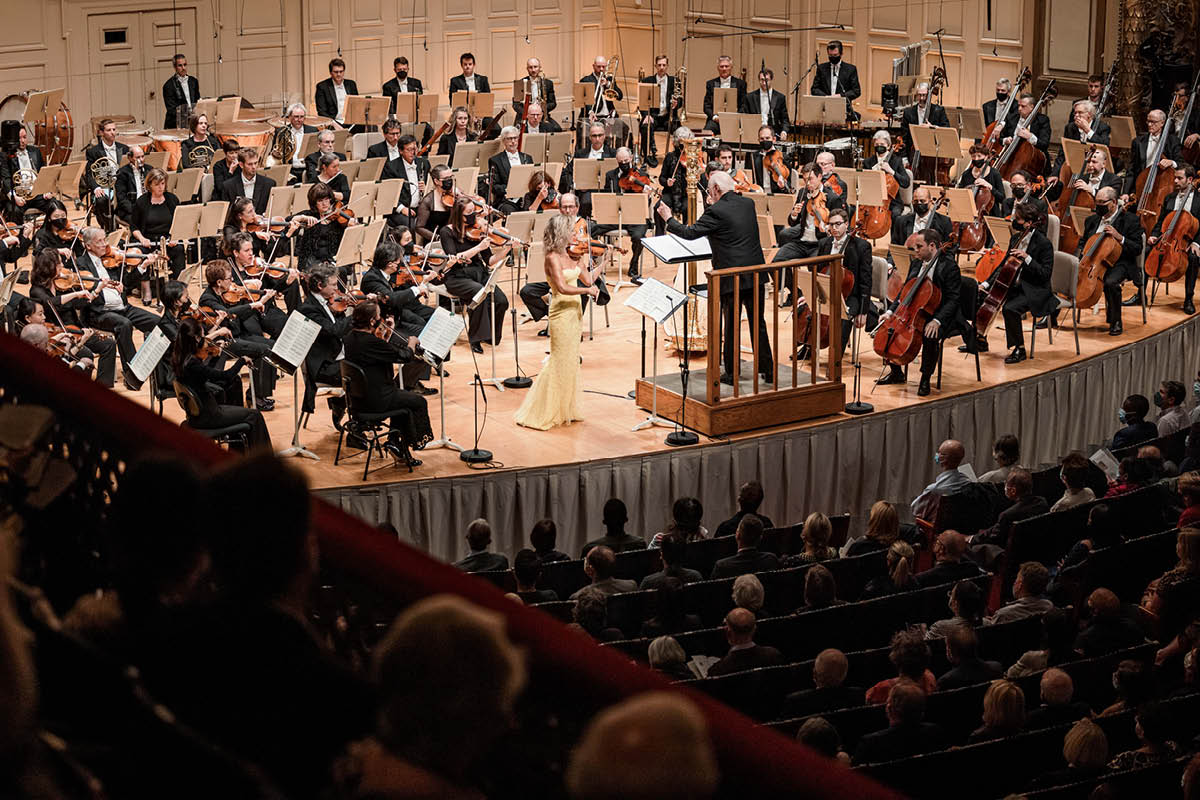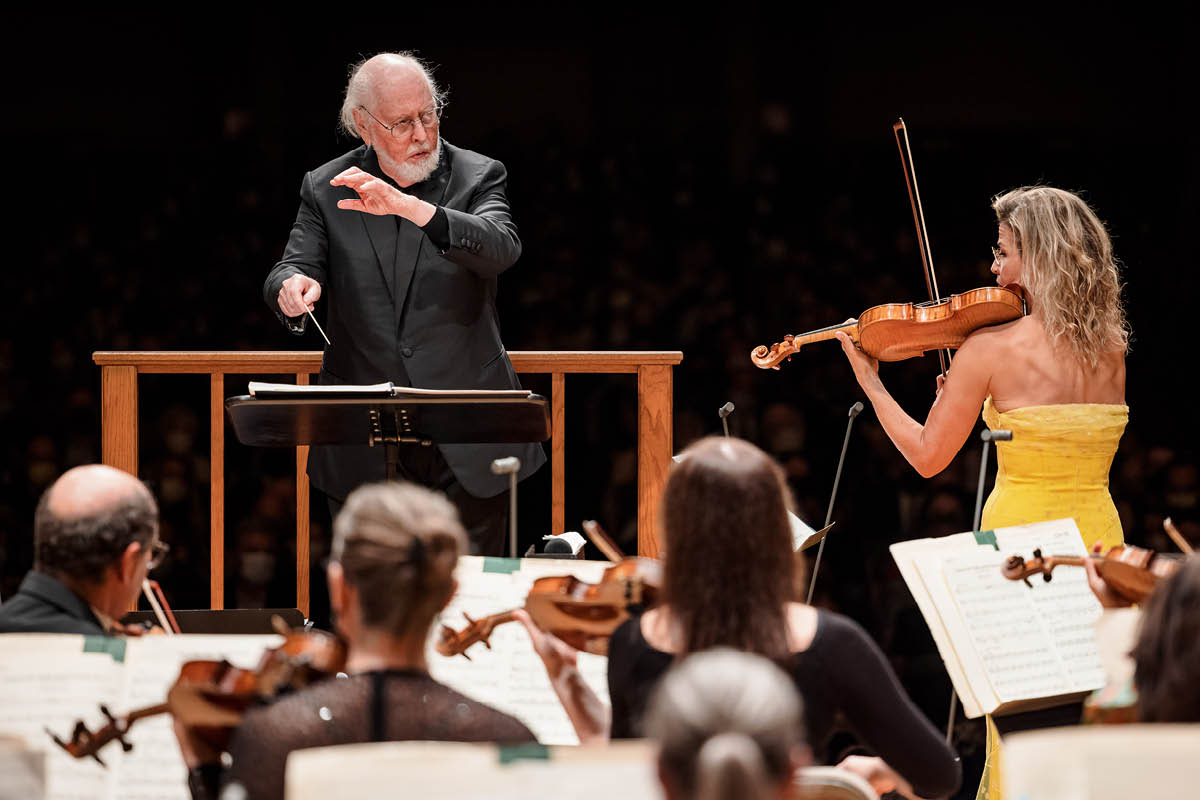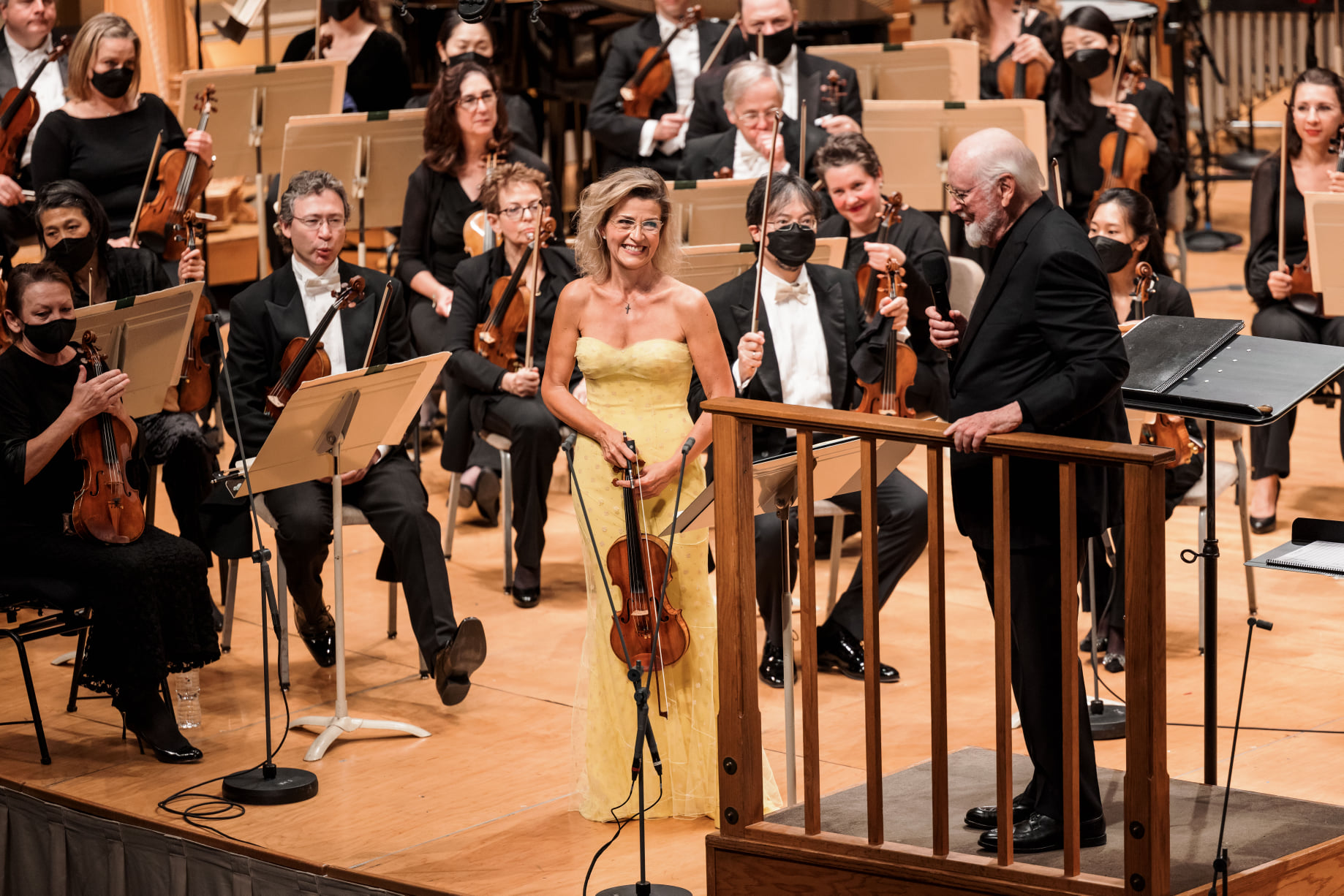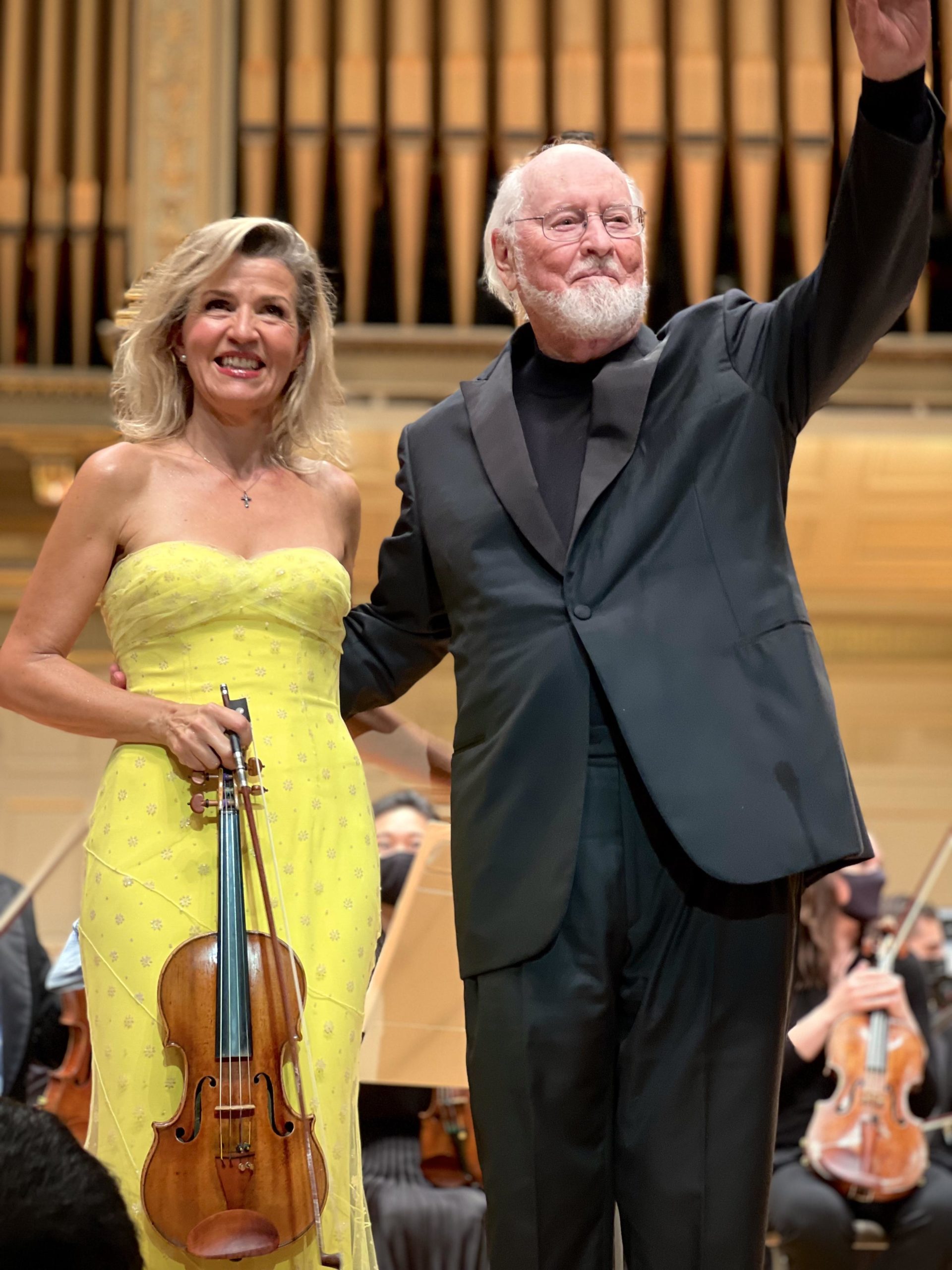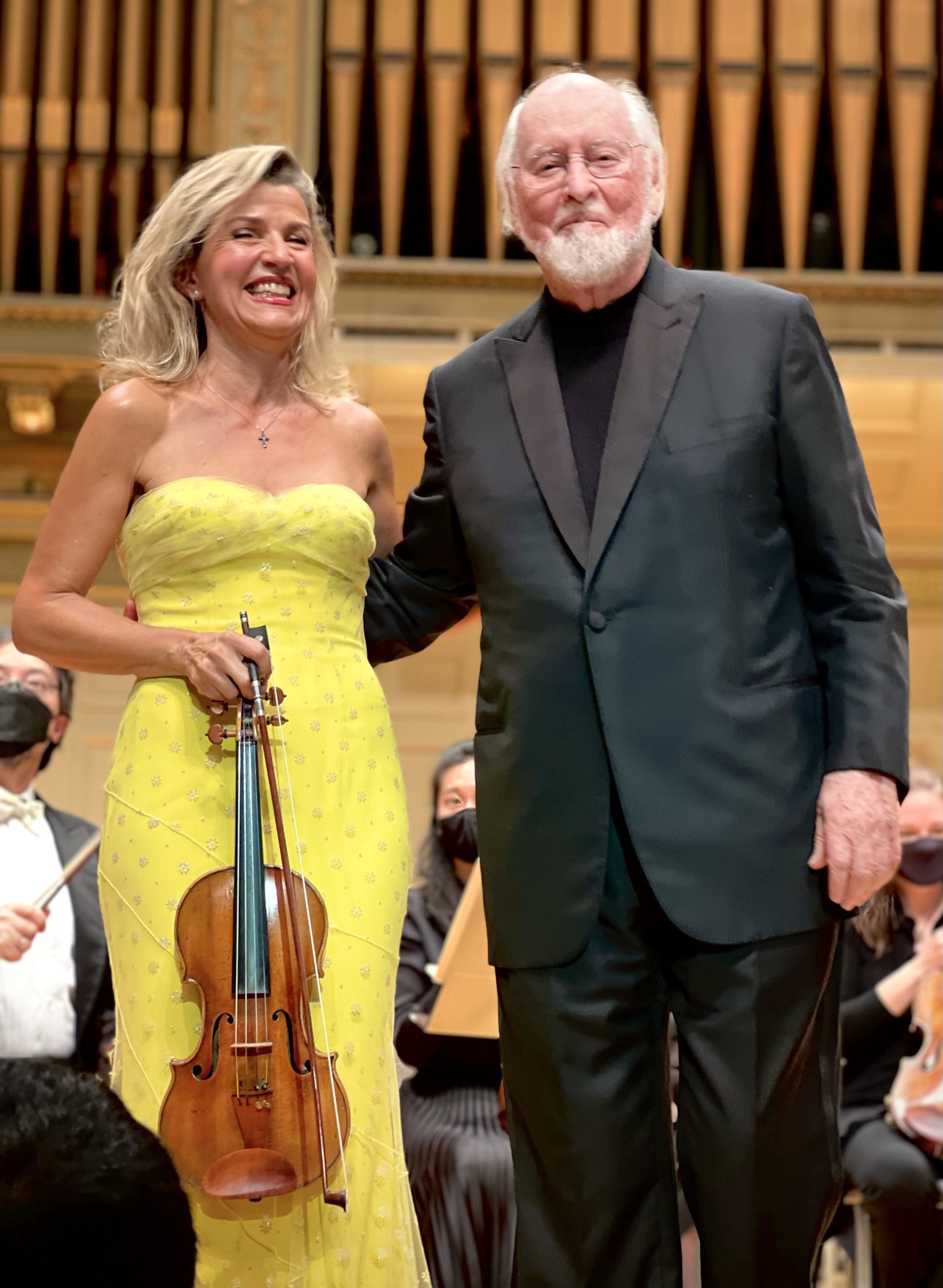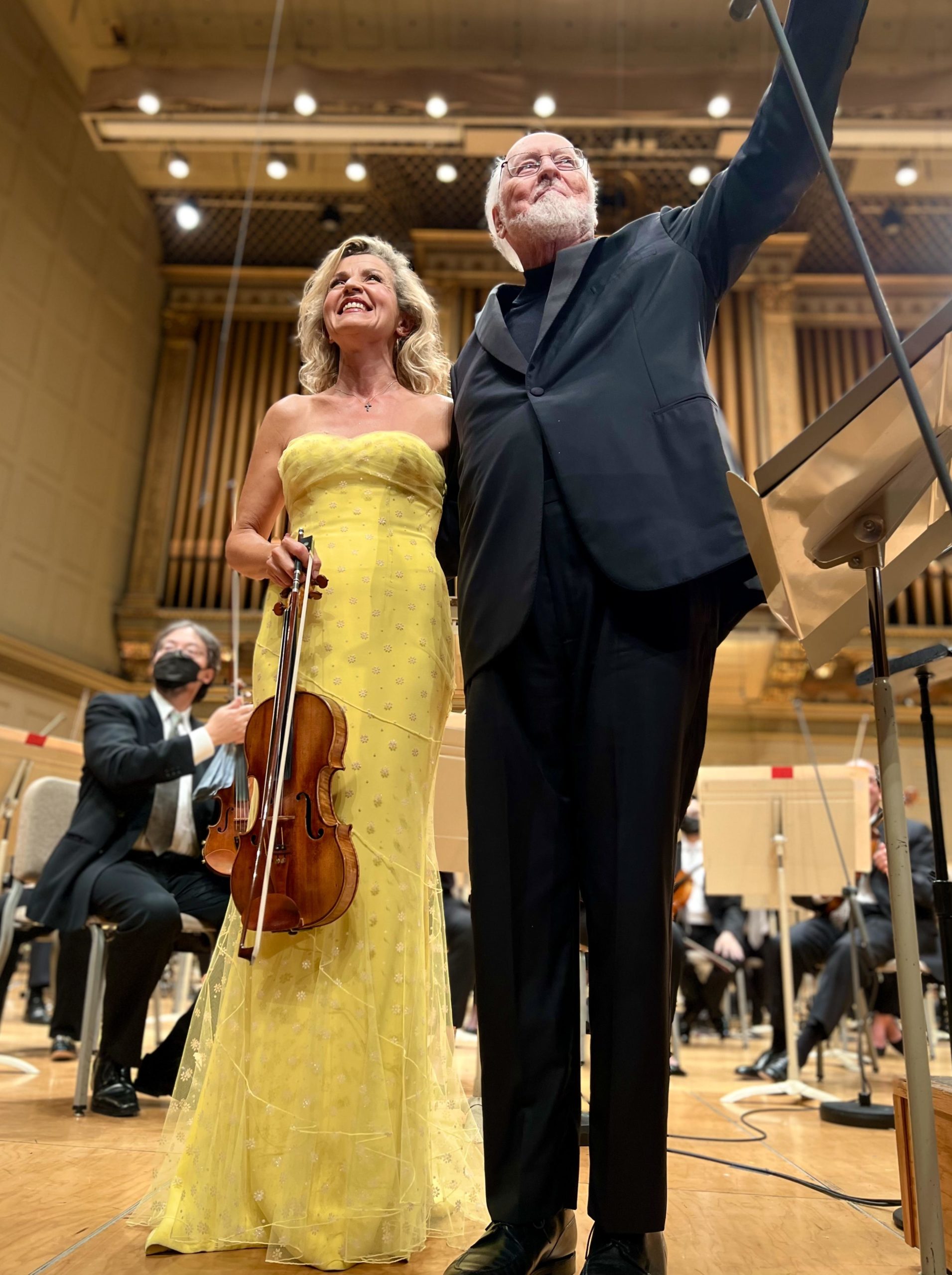“Andris Nelsons and JOHN WILLIAMS conduct Beethoven, Williams, and Bartok”
(JOHN WILLIAMS’ ‘VIOLIN CONCERTO No.2’ BOSTON PREMIERE)
September 30 & October 2, 2021, Boston, MA
The Boston Pops Orchestra conducted by Andris Nelsons and JOHN WILLIAMS
Anne-Sophie Mutter, violin
—-
“Free Community Concert”
October 3, 2021, Boston, MA
The Boston Pops Orchestra conducted by JOHN WILLIAMS, Andris Nelsons, Keith Lockchart and Thomas Wilkins
Anne-Sophie Mutter, violin
—-
CONCERT PROGRAM (Sept. 30 & Oct. 2)
Conducted by Andris Nelsons
- Overture, The Consecration of the House (Beethoven)
Conducted by John Williams
- Violin Concerto No. 2
- Love Theme from The Long Goodbye (Sept. 30)
- Marion’s Theme from Raiders of the Lost Ark (Oct. 2)
INTERMISSION
Conducted by Andris Nelsons
- Concerto for Orchestra (Bartók)
CONCERT REVIEWS (Sept. 30 & Oct. 2)
- Boston Globe – The richly textured piece had its premiere performance at Tanglewood just over two months ago, and time has been kind to it. On the whole, the performance was more cohesive, and Mutter’s interpretation felt more deeply rooted, seesawing between the robust and sweet and the jagged and acidic with just a flick of her bow. Williams wielded the baton with the vitality of some conductors half his age, leaving the showiness to Mutter and the music.Principal harpist Jessica Zhou also played a critical role as a frequent partner for the soloist, and it was a treat to hear her instrument thrumming like an electric bass, far from the glissandos and pretty percussion to which the harp is often relegated. It’s at times like this that I deeply envy my colleagues on the food desk; no one would think of asking them to put words on a page after sampling a dish only once.This repeat listen also made the piece’s weak points more evident. The first of these is that it’s too long, second (and compounding the first) is that the final movement and a half feature the least compelling music, and the major-key ending felt tacked on in a hurry after so much chromaticism. Williams and Mutter offered an encore to the tune of Williams’s plaintive love theme from “The Long Goodbye,” with the orchestra playing backup to Mutter’s keening violin. – Full review
- Boston Classical Review – Though best known for his film scores, Williams has also crafted a substantial body of concert music. Broadly speaking, the latter can be more abstracted in tone and less expressively affecting than his commercial work.Not so his Second Violin Concerto. Written for Mutter and premiered by her in July at Tanglewood, it’s a magisterial piece, full of bold contrasts of mood, textures, dynamics, and colors. The score’s points of reference—to jazz, popular song, the cinema, and the 20th-century canon—are discreet, its orchestration luminous.The opening “Prologue” is both the longest and most diffuse of the concerto’s four movements. But its divergent structure is held together by recurring, pseudo-improvisatory turns for violin and harp, as well as fiery, toccata-like episodes for the soloist and some soaring melodic lines in the orchestra.While the “Prologue” is often tempestuous, the second movement, “Rounds,” is more subdued. Here, Williams’ writing is vaguely Impressionistic—in outer thirds, the solo line dances lyrically over a hazy bed of lush woodwind sonorities. Things take a more reflective turn in the probing central section.“Rounds” is followed by a lusty, stuperous waltz, titled “Dactyls.” With its tipsy, insistent solo lines, snarling, muted brass interjections, and a wild, culminating trio for violin, harp, and timpani, one is never quite sure if the music’s aim is more to amuse or to menace.The finale, though, builds to a consolatory apotheosis. In it, searching, meditative figures are passed between orchestra and soloist; they’re finally resolved in a touching reprise of the second movement’s introspective second theme.Suffice it to say, the whole piece is tailor-made for Mutter, whose rich tone, flexible vibrato, pristine intonation, penchant for expressive swoops, and evident love of jazz are all put through their paces. Her account of the solo part Thursday was intensely focused but never lost sight of the music’s broader, expressive aims.Leading the BSO, Williams drew blazing colors from the orchestra. Calling it “really a treat” to be back at Symphony Hall, he led Mutter and the ensemble in a new arrangement of the “Love Theme” from his 1972 score to Robert Altman’s The Long Goodbye as an encore. – Full review
- Edge Media Work – Williams, of course, has a long history on the Symphony Hall podium, having conducted the Boston Pops for 13 seasons; but those expecting the Williams they know from his movie scores, which has made him the most famous living composer in the world, were likely taken aback by the dense modernity of his score. Williams’ musical language is rooted in mid-20th century serialism, not film music rooted in late 19th century Romanticism. Think Alban Berg, not Indiana Jones.The work did, nonetheless, exhibit his masterful skills at orchestral sonics, echoing the big sound of his film scores at crucial moments. It is an inventive work — what other concerto can boast a conversation between the soloist and the tympanist? And has a generously written solo part, with what appears to be two cadenzas for Mutter to exhibit her prodigious skills. But, in some ways, it is difficult to evaluate such a thorny work on one hearing. What stays in the memory Mutter’s furious playing in the second movement that acted as a counterpoint to orchestra’s long phrases, and the work’s conclusion, which appeared to bring it back to the mysterious sounds of its onset. But the work seemed to wander, and, aside from giving Mutter a most challenging solo part, never quite connected emotionally — most unusual for Williams, who has built his career on scores that do precisely that.There was a touch of his film music when Mutter joined him for an encore — the lush love theme to the Robert Altman’s Neo-noir “The Long Goodbye,” which only left one wanting more. – Full review
- Bachtrack – John Williams conducted the world premiere of his Violin Concerto no. 2 in July at Tanglewood. Written for and dedicated to Anne-Sophie Mutter, it exploits her mastery of color and rhythm (Williams specifically mentions her “flair for an infectious rhythmic swagger” in his program note as an inspiration.) in an eventful four movements of kaleidoscopic incidents lasting approximately 37 minutes. Williams’ film scores fly on their melodies; his concert pieces tend to be rhythmically driven. This concerto is no exception. Aside from a few rhapsodic passages, the violin approximates the cadence of speech in a variety of voices expressed with rhythmic variety and rising from a spectrum of moods – by turns angry, hopeful, insistent, sassy, contemplative, annoyed, bawdy, argumentative.The orchestra rarely answers and most often in chamber groupings, one of the most ear-catching a cadenza in the third movement involving violin, harp and timpani. For the most part, the violin is alone. Only Jessica Zhou’s harp really listens and interjects, in dialogue with the violin from a seat to the right of the podium, usually with a calming effect. In a conclusion reminiscent of Berg’s concerto, Williams has Mutter spin an iridescent filament of sound, which didn’t so much fade as become one with the air around it. – Full review
CONCERT REPORT (October 3)
Report by ‘rpvee’ (original post)
Chills. Absolute chills. I have paid a pretty penny several times over the years to see the Maestro conduct his work only feet away. I’ve never taken it for granted, but something about it being free today made it all the more surreal.
The three pieces Williams and Mutter did were indeed The Long Goodbye, Marion’s Theme, and Han Solo and The Princess (which took an already stunning theme to unbelievable new heights). Williams also came out at the end of the concert with the three other conductors, and they left him to do an encore of The Imperial March.
Truly surreal!
PHOTOS (Sept. 30)
(Source: BSO)
PHOTOS (Oct. 3)

